When you add a dietary supplement to your daily routine, you’re introducing a biologically active substance that can influence the way your body processes prescription or over‑the‑counter (OTC) medications. While many people assume that “natural” automatically means “safe,” the reality is far more nuanced. Supplements can alter drug absorption, distribution, metabolism, and excretion (ADME), potentially amplifying therapeutic effects, diminishing efficacy, or precipitating adverse reactions. Understanding the underlying mechanisms, recognizing which medication classes are most vulnerable, and adopting a systematic approach to evaluating risk are essential steps for anyone who wishes to combine supplements with their medication regimen responsibly.
Why Interactions Occur
Pharmacokinetic vs. Pharmacodynamic Interplay
- Pharmacokinetic interactions involve changes in the way a drug is handled by the body. A supplement might increase gastric pH, bind to a drug in the gut, or modulate liver enzymes that metabolize the medication, thereby affecting the drug’s concentration in the bloodstream.
- Pharmacodynamic interactions occur when a supplement and a medication act on the same physiological pathway or receptor, leading to additive, synergistic, or antagonistic effects. For example, a supplement that lowers blood pressure can intensify the hypotensive action of an antihypertensive drug.
Enzyme Induction and Inhibition
The cytochrome P450 (CYP) family of enzymes, particularly CYP3A4, CYP2D6, CYP2C9, and CYP1A2, are responsible for metabolizing a large proportion of prescription drugs. Certain botanicals and nutrients can either induce (increase activity) or inhibit (decrease activity) these enzymes:
| Enzyme | Common Inducers (Supplements) | Common Inhibitors (Supplements) |
|---|---|---|
| CYP3A4 | St. John’s wort, green tea catechins (high doses) | Grapefruit juice (though technically a food), goldenseal, curcumin (high concentrations) |
| CYP2D6 | – (few strong inducers) | Quercetin, berberine |
| CYP2C9 | – | Ginkgo biloba |
| CYP1A2 | – | Flavonoid‑rich extracts (e.g., certain cranberry products) |
Transporter Modulation
Drug transporters such as P‑glycoprotein (P‑gp) and organic anion transporting polypeptides (OATPs) influence drug movement across cell membranes. Supplements that inhibit P‑gp (e.g., reserpine‑containing herbs) can raise plasma levels of P‑gp substrates like certain chemotherapeutic agents, while inducers (e.g., St. John’s wort) may lower them.
Alterations in Gastrointestinal Environment
Some supplements change gastric acidity or motility. Calcium carbonate, magnesium hydroxide, and antacids raise pH, potentially reducing the absorption of drugs that require an acidic environment (e.g., ketoconazole). Fiber supplements can bind drugs, decreasing their bioavailability.
Key Pharmacokinetic Pathways Affected by Supplements
- Absorption
- pH‑dependent drugs: Acid‑labile drugs (e.g., certain antifungals) may have reduced absorption when taken with alkaline supplements.
- Chelation: Divalent cations (calcium, magnesium, iron, zinc) can form insoluble complexes with antibiotics (tetracyclines, fluoroquinolones) and bisphosphonates, impairing uptake.
- Distribution
- Protein binding displacement: Highly protein‑bound drugs (e.g., warfarin, certain SSRIs) can be displaced by supplements containing high levels of fatty acids or certain flavonoids, increasing the free (active) fraction.
- Metabolism
- CYP modulation (see table above).
- Phase II conjugation: Supplements rich in glucuronic acid precursors (e.g., certain polysaccharides) may accelerate glucuronidation of drugs, hastening clearance.
- Excretion
- Renal tubular secretion: Supplements that affect organic anion transporters can modify the renal clearance of drugs like methotrexate.
- Biliary excretion: Certain botanicals can up‑regulate bile acid transporters, influencing the elimination of drugs cleared hepatically.
Common Medication Classes Prone to Interactions
| Medication Class | Typical Interaction Mechanism | Representative Examples |
|---|---|---|
| Anticoagulants / Antiplatelet agents | Pharmacodynamic (enhanced bleeding) & CYP inhibition (e.g., warfarin) | Warfarin, clopidogrel |
| Statins | CYP3A4 inhibition → increased statin levels → myopathy risk | Atorvastatin, simvastatin |
| Antidepressants (SSRIs, SNRIs, MAOIs) | Serotonin syndrome (pharmacodynamic) & CYP inhibition | SSRIs (fluoxetine), MAOIs |
| Antihypertensives (ACE inhibitors, ARBs, beta‑blockers) | Additive blood pressure lowering; altered renal handling | Lisinopril, metoprolol |
| Immunosuppressants | CYP induction or inhibition → sub‑ or supra‑therapeutic levels | Cyclosporine, tacrolimus |
| Antibiotics (fluoroquinolones, tetracyclines) | Chelation with divalent cations → reduced absorption | Ciprofloxacin, doxycycline |
| Thyroid hormone replacement | Binding to fiber or calcium → decreased absorption | Levothyroxine |
| Diabetes medications (insulin, sulfonylureas) | Pharmacodynamic (hypoglycemia) & CYP modulation | Metformin, glipizide |
> Note: The table highlights typical patterns; individual responses can vary based on dosage, formulation, and patient-specific factors.
Assessing Your Personal Risk
- Compile a Complete List
- Write down every prescription, OTC drug, and supplement (including multivitamins, herbal extracts, and “proprietary blends”). Include dosage, frequency, and timing.
- Identify Overlap Zones
- Look for supplements that contain minerals (calcium, magnesium, iron, zinc) or high‑dose vitamins (e.g., vitamin K) that are known to interact with specific drug classes.
- Consider Timing
- Even when a supplement is not a direct inhibitor, spacing the intake can mitigate absorption issues. A general rule: take mineral‑containing supplements at least 2 hours apart from drugs that may chelate them.
- Evaluate Enzyme Interaction Potential
- Use reputable databases (e.g., Natural Medicines Comprehensive Database, FDA’s Drug Interaction Database) to check whether a supplement is a known CYP inducer or inhibitor.
- Account for Formulation Differences
- Extended‑release (XR) or enteric‑coated tablets may be more sensitive to pH changes than immediate‑release forms.
Practical Strategies to Minimize Interaction Risks
- Separate Administration Times
- Mineral‑containing supplements: Take at least 2 hours before or after medications that rely on gastric acidity or are prone to chelation.
- Fiber supplements: Ingest at a different meal or time of day from drugs with narrow therapeutic windows.
- Start Low, Go Slow
- When introducing a new supplement, begin with the lowest effective dose and monitor for any changes in symptom control or side‑effects.
- Use Standardized Extracts
- Prefer supplements that disclose the exact amount of active constituents (e.g., “standardized to 5 % hypericin”) rather than vague “proprietary blends,” which makes interaction prediction more reliable.
- Monitor Laboratory Parameters
- For drugs with therapeutic drug monitoring (e.g., warfarin INR, lithium levels, tacrolimus trough), schedule more frequent checks after adding or removing a supplement.
- Document Changes
- Keep a log of any new supplement, dosage adjustments, and observed clinical effects. This record is invaluable for clinicians during follow‑up visits.
- Avoid “Mega‑Doses”
- High‑dose vitamin C, vitamin E, or omega‑3 fatty acids can exert enzyme‑modulating effects not seen at typical dietary levels.
Tools and Resources for Ongoing Management
| Resource | What It Offers | How to Use It |
|---|---|---|
| Natural Medicines Comprehensive Database | Evidence‑based interaction ratings, dosing guidelines, safety alerts | Search by supplement name; filter for “drug interactions.” |
| U.S. National Library of Medicine’s DailyMed | Official drug labeling, including known supplement interactions | Review the “Drug Interactions” section for each prescription. |
| Medscape Drug Interaction Checker | Quick cross‑reference of drug‑drug and drug‑supplement combos | Input medication and supplement names; note severity flags. |
| Pharmacy Consultation Services | Direct access to pharmacists trained in pharmacokinetics | Bring your supplement list; ask for a personalized interaction review. |
| Mobile Apps (e.g., MyMeds, Medisafe) | Medication reminders with optional supplement entries | Set alerts to separate dosing times; track adherence. |
When to Seek Professional Help
- Unexpected Symptoms – New onset of dizziness, bleeding, excessive sedation, or rapid heart rate after starting a supplement.
- Laboratory Abnormalities – Sudden changes in blood counts, liver enzymes, or therapeutic drug levels without an obvious cause.
- Complex Regimens – More than three prescription drugs combined with multiple supplements; a pharmacist or clinical pharmacologist can map interactions comprehensively.
- Pre‑Surgical Planning – Many supplements (e.g., omega‑3 fatty acids, ginkgo) increase bleeding risk; disclose all products well before any procedure.
Bottom Line
Combining supplements with prescription or OTC medications is a common practice, but it is not without risk. By understanding the fundamental ways supplements can influence drug pharmacokinetics and pharmacodynamics, recognizing which medication classes are most susceptible, and employing systematic risk‑assessment strategies, you can enjoy the potential benefits of supplementation while safeguarding therapeutic efficacy and safety. The cornerstone of this approach is open communication with healthcare providers, meticulous record‑keeping, and the judicious use of reliable information resources. Armed with this knowledge, you can make informed decisions that support both your nutritional goals and your overall health regimen.





